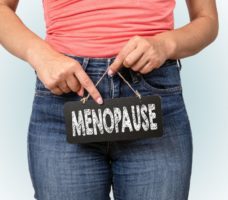Before you transition into full menopause, you might experience some uncomfortable symptoms. Here’s what you can expect, along with six tips for managing perimenopause.
Perimenopause is a confusing time for many women. Not quite menopause, but not normal menstruation either, perimenopause means “around menopause” and is the season of life where the body transitions to menopause. But what should you be expecting during this time, and how can you make the transition easier?
What Is Perimenopause?
Perimenopause signals the beginning of the end of the reproductive years, but the age at which it begins is different for every woman. The first signs of it are typically menstrual irregularity, which some women may notice as early as their mid- to late thirties. For most women, perimenopause occurs in the early forties. (1)
Struggling to lose weight? Unable to focus? Chances are, your hormones are out of whack.
Grab Our FREE Guide To Fixing Your Hormones By Clicking Here!
The change in the menstrual cycle happens because of changing levels of . During the reproductive years, estrogen rises and falls in balance with progesterone, which is what causes a regular cycle. As perimenopause begins, estrogen levels may rise higher or not as much, and ovulation may not be regular, leading to lower levels of progesterone.
Women who experience perimenopause may notice that their cycle gets longer or shorter, or sometimes alternates between the two. Symptoms characteristic of menopause, such as hot flashes or trouble sleeping, may also appear. Perimenopause can last for months or years, sometimes as many as 10 years, before menopause fully sets in. You’re not officially in menopause until it has been an entire year without a single menstrual period.
Symptoms of Perimenopause
While perimenopause is a broad term referring to the transition time between reproductive ability and menopause, there are many common symptoms. Some women may experience all of them, none of them, or they may be staggered over months and years.
- Hot flashes
- Sleep problems (mostly due to hot flashes or night sweats)
- Irregular periods
- Mood swings and changes
- Vaginal dryness
- Bladder problems such as incontinence or frequent UTIs
- Changes to sex drive and function
- Bone loss
- Weight gain and inability to lose weight
- Thinning hair
- Dry skin
- Breast changes
- Heart palpitations
- Reduced ability to concentrate
While perimenopause signals the start of menopause, it is still possible to become pregnant during this phase. While the chances significantly decrease when periods become irregular, any time that a woman is menstruating, pregnancy is possible. “Bonus” pregnancies can happen especially when women no longer have regular cycles and have trouble knowing when ovulation occurs. Therefore, contraception should be used during perimenopause to avoid pregnancy until menstruation has ceased for at least 12 consecutive months.
6 Ways to Manage the Transition to Menopause
While doctors may use one or more medications to address the discomfort of perimenopause (such as hormone replacement), some of these prescriptions come with their own set of uncomfortable side effects.
Luckily, there are several ways to ease the transition into and through perimenopause.
1. Eat to Balance Hormones
While nutrition is essential at every phase of life, certain foods can benefit or worsen symptoms of perimenopause. Sugar, refined and processed foods, alcohol, caffeine, and an overconsumption of omega-6 fatty acids can lead to increased inflammation levels in the body, aggravating symptoms like hot flashes. (4)
Thyroid disease, arthritis, and other similar conditions are most commonly diagnosed in women at this age, so looking out for your overall health by eating a Paleo diet rich in vegetables, fruits, grass-fed and pastured meats, seafood, and omega-3 fatty acids will help to minimize hormone chaos.
2. Get Daily Exercise
Regular movement can also help to decrease the unpleasant number of perimenopause symptoms. Specifically, HIIT workouts and other cardio workouts can help to decrease length and regularity of hot flashes. (5) Exercise also helps to better cope with mood swings, fluctuating hormone levels, and other symptoms of a disrupted cycle like bloating, digestive upset, and constipation. (6) Exercise that involves weightlifting of some kind, including kettlebells, can also help to support bone density and protect against osteoporosis or brittle bones. (7)
3. Supplement with Key Nutrients
Women in perimenopause are at risk of bone loss, making nutrients even more essential for helping to maintain strength. Nutrients that are most important to perimenopausal women include: (8)
- Vitamin D
- Calcium
- Magnesium
- Iron
- Vitamin C
- B vitamins
A solid multivitamin can also be beneficial to both supply these essential nutrients and support the nervous system during this time of stress.
Note: Remember to seek medical guidance before starting supplemental support, particularly because some vitamins can become toxic if taken at excessive doses.
4. Consider Acupuncture
Acupuncture can help address hormone-related chaos that takes over during the perimenopause years. It can also help the body cope with stress and anxiety, which can become common themes in perimenopausal women.
While research on acupuncture for hot flashes is limited, it shows some potential, with far fewer side effects than hormone replacement protocols. (9) Acupuncture has few risks and can be done regularly or on an as-needed basis, although beneficial effects are noted more after regular sessions.
5. Get Plenty of Sleep
While perimenopause symptoms can make it harder to keep to a healthy sleep routine, it’s essential to not give up on it completely. Being well-rested can help the body better cope with the stress of hormone changes and altered brain function, which can help reduce overall symptoms and discomfort.
Seven to eight hours of sleep is ideal for the most health benefits, and even if you’re frequently interrupted in the night from hot flashes, it’s important to try to carve out that much sleep time.
Caffeine and alcohol can both contribute to sleep disturbances while also worsening hot flashes, so they’re best avoided entirely during perimenopause. (10)
6. Try Yoga
Yoga can help soothe hormone-related symptoms like hot flashes, anxiety, and mood swings, and can also promote more restful sleep. (11) Whether you attend a yoga class or practice from your living room, yoga’s benefits can improve the quality of life for women going through perimenopause.
Bottom Line
Perimenopause is a season of transition that, for some, can last as little as four months or as long as 10 years. It’s a natural change, but symptoms and discomfort can be minimized by practicing lifestyle support and eating a nutritionally rich diet.
(Read This Next: The Best and Worst Foods for Your Period)
This content was originally published here.









